Embroidery digitization has become increasingly popular in recent years, allowing individuals and businesses to create intricate and personalized designs with ease.
Table of Contents
ToggleHowever, like any technical process, digitizing can encounter a few challenges along the way. In this blog, we will explore five common digitizing issues and provide troubleshooting tips to help you overcome them.
Whether you’re a seasoned digitizer or just starting, these insights will prove valuable in your journey toward flawless embroidery digitization.
Embroidery Digitizing Services
If you are looking for embroidery digitizing services, EMDigitizer is one of the best embroidery digitizing companies. Providing all types of embroidery digitizing. I recommend you try digitizing services.
Order NowGet Free QuoteIntroduction
Embroidery digitizing refers to the method of modifying artwork, designs, or logos into a digital file that can be read by a machine.
The file contains instructions that guide the needle to stitch the design onto fabric and other materials accurately.
The digitizer considers factors like stitch direction, stitch density, underlay stitches (to provide stability), and thread color changes to ensure that the design is faithfully translated into an embroidered form.
This is the complete list of types of embroidery digitizing services offered by Emdigitizer’s team.
The software allows the digitizer to allocate the types of stitches and sequences to different parts of the design, defining how the machine will sew each part.
Once the embroidery digitizing process is complete, the design will be saved in a specific format the embroidery machine can read such as DST (Tajima), PES (Brother), or EXP.
Want to get the complete guide about machine embroidery file format, click here.
Moreover, the process of embroidery digitizing plays a crucial role in the customization industry, allowing businesses and individuals to replicate complex designs on a wide range of products:
- Garments
- Hats
- Bags etc
It offers flexibility, speed, and accuracy in producing high-quality embroidered items, whether for personal use, branding, or promotional purposes.
Reasons For Acquiring Embroidery Digitizing Issues
Embroidery Digitizing issues can occur due to various factors and circumstances and here are some common reasons why digitizing issues may arise:
Low-resolution Or Poor-quality Of Using Material:
If the original material being digitized, such as images, documents, or videos, has a low resolution or is of poor quality, it can lead to issues during the digitization process. This can result in blurry or distorted digitized versions.
Conversion Errors:
During the process of converting analog formats (such as physical documents, images, or audio) into digital formats, errors can occur.
These errors may be introduced due to technical glitches, software or hardware limitations, or improperly dealing during the digitization process.
Go and get a review of the best free machine embroidery file format converters to ensure error-free conversion.
Compression Artifacts:
When data is compressed to reduce file size during digitization, some information may be lost or distorted and this can result in artifacts such as pixelation, blocky images, or loss of fine details.
Incorrect Settings Or Parameters:
Improper configuration of digitization equipment or software settings can lead to issues such as using incorrect color profiles, resolution settings, and compression algorithms that can affect the quality of the digitized output.
Inadequate Calibration Or Maintenance:
Digitization equipment, such as scanners or cameras, needs regular calibration and maintenance to ensure an accurate and high-quality digitization process.
That’s why failure to calibrate or maintain the equipment or tools used in embroidery digitizing can result in digitizing issues.
Human Errors:
Mistakes made by operators during digitizing, such as improper handling of source materials, incorrect settings selection, or mishandling of equipment, can introduce issues in the digitized output.
Time And Resource Constraints:
In some cases, digitization may be performed under tight deadlines or with limited resources. These constraints can lead to shortcuts or compromises in the digitization process, resulting in lower-quality digitized outputs.
To mitigate digitizing issues, it is important to use:
- High-quality source material
- Ensure proper equipment calibration and maintenance
- Employ skilled operators and adhere to the best standards for digitization processes.
Moreover, regular quality checks and validation can also help identify and address any issues that arise during the process of digitization.
Common Digitizing Issues And Troubleshooting Tips
In our blog, we will explore and provide solutions to some of the common digitizing issues faced by enthusiasts.
1)Poor Image Quality:
One of the most common problems in digitizing is poor image quality. This can manifest as blurry, pixelated, or distorted images. Here are a few possible solutions for troubleshooting these kinds of embroidery digitizing issues.
Troubleshooting Tips
Tip#1: Ensure that you have selected the appropriate resolution and image settings. Higher resolutions generally produce better quality, but they may result in larger file sizes.
Tip#2: Dust or smudges on the scanner or camera lens can significantly impact image quality so clean them gently using a microfiber cloth to remove any dirt or fingerprints.
Tip#3: Insufficient lighting can lead to grainy or dim images. Optimize the lighting conditions by using natural light or supplementary lighting sources to enhance the clarity of your digital captures.
For professional quality results, here we have included the top 5 best embroidery digitizing services provider companies in our blog for getting the best digitizing services.
2) File Compatibility Issues:
Sometimes, digitized files may not be compatible with the intended software or devices. Here’s how you can troubleshoot embroidery digitizing issues of file compatibility:
Troubleshooting Tips
Tip#1: Select popular file formats such as JPEG, PNG, or PDF for maximum compatibility across different platforms and applications.
Tip#2: If you have incompatible files, convert them to a suitable format using file conversion tools or online services.
Check out the list of free embroidery file converters given in this blog.
Tip#3: Ensure that the applications you are using for digitizing are up to date. Newer versions often support a broader range of file formats.
Tip#4: Always keep a backup of your original digitized files. If you encounter compatibility issues, you can refer back to the original files and try different conversion options.
3) Color And Contrast Issues
Color accuracy is crucial, especially when digitizing photographs or artwork so if your digitized images exhibit incorrect colors, try these troubleshooting tips for such embroidery digitizing issues.
Troubleshooting Tips
Tip#1: Improper display calibration can lead to color discrepancies between the source and the digitized version. Use display calibration tools or software to ensure accurate color representation.
Tip#2: If the images appear too warm (yellowish) or too cool (bluish), adjust the white balance settings on your camera or scanner to match the lighting conditions.
Tip#3: If the color inaccuracies persist, utilize image editing software to manually adjust the color balance, saturation, and contrast levels of the digitized images.
You can also consider using thread color conversion chart lists given in this blog to avoid color and contrast issues.
4) Using Digitizing Tools Incorrectly:
Digitizing software often provides tools to automate certain aspects of the digitizing process. While these tools can be helpful, they must be used correctly to avoid problems.
Let’s consider the example of underlay settings. Underlay stitches are essential for providing stability and foundation to the design.
Visit the blog to learn more about underlay stitches for embroidery digitizing and their types so you can apply them correctly.
However, using the wrong stitch length for underlay can create issues. For instance, if the stitch length is set too short, the underlay stitches will be too close together, leading to problems during embroidery.
Troubleshooting Tips
Tip#1: Familiarize yourself with the tools available in your application and their proper usage.
Read out the blog to learn more about the best embroidery digitizing software for editing to get high-quality digitizing results.
Tip#2: Make sure you are selecting the appropriate tool for the desired effect. For example, use the correct stitch type for outlines, fills, or lettering.
Tip#3: Avoid excessive use of automatic tools and consider manual adjustments to fine-tune the digitized design.
Tip#4: Take advantage of features like stitch editing, node manipulation, and path adjustments to correct any issues caused by incorrect tool usage.
5)Stitches Placed In The Wrong Location:
Precision is crucial in digitizing. Even a slight displacement of a stitch can result in significant quality issues in the final embroidery.
When digitizing, you’re essentially setting points to create an outline, and the software fills in the stitches based on those points. Therefore, it’s vital to ensure accurate stitch placement.
If stitches are placed incorrectly, the design may appear distorted or have irregularities when embroidered.
Troubleshooting Tips
Tip#1: Review the original artwork or design and compare it with the digitized version. Ensure that stitches are placed accurately, following the intended shape and contours of the design.
Tip#2: Check if any unnecessary or extra stitches may be causing distortion or misplacement.
Tip#3– Experiment with adjusting the stitch angles, stitch types (e.g., satin stitch, fill stitch), and stitch lengths to improve the placement and accuracy.
6) Sequencing Errors:
The sequence in which you program the elements of a design can affect its final appearance.
Following proper programming sequence protocols is crucial, especially for specific applications like embroidery on caps or other garments.
For instance, when embroidering text and borders, it is generally suggested to sew the words first, followed by the border for better registration fills to ensure the design stitches out correctly.
Troubleshooting Tips
Tip#1: Review the order in which stitches are programmed. Ensure that they follow a logical sequence to avoid unnecessary jumps or overlaps.
Here’s complete guidance about what are jump stitches and tips to avoid these unwanted jumps to ensure flawless results.
Tip#2: Check for missing or skipped stitches that could result in incomplete or incorrect designs.
Tip#3: Use the software’s simulation or preview feature to visually inspect the design’s stitching sequence and identify any potential errors.
Tip#4: If possible, run a test stitch-out of the design on a sample fabric to detect any sequencing errors that may not be apparent in the digital preview.
While digitizing can be an artistic and subjective process, it’s important to follow certain rules to ensure the design stitches properly.
The examples mentioned in this blog post only scratch the surface of potential digitizing issues. Take the time to learn how different settings and tools affect your designs.
Want to become a master in the digitizing industry? Read out the tips to become a successful embroidery digitizer provided in this blog.
Conclusion
Digitizing embroidery designs can be a challenging yet rewarding process. By addressing the common digitizing issues discussed in this blog post, you can troubleshoot and overcome various embroidery digitizing hurdles.
Remember, the key to successful digitizing is attention to detail and a deep understanding of the digitizing software and tools you’re using.
Practice, experimentation, and continuous learning will improve your digitizing skills and you’ll be able to overcome common digitizing issues and create high-quality embroidery designs.
Some common digitizing issues include:
- Poor image quality or resolution.
- Incorrect color reproduction.
- Jagged or distorted lines.
- Uneven stitching or gaps.
- Alignment or registration problems.
- File format compatibility issues.
- Inconsistent thread tension.
- Thread breakage during the digitizing process.
If the colors in your digitized image appear inaccurate, calibrate your scanner or monitor to ensure color accuracy. You can also adjust the color settings or use color correction tools in image editing software to correct any color discrepancies.
To prevent loss of image quality, use the highest resolution and quality settings available on your device. Avoid excessive post-processing, such as excessive sharpening or noise reduction, as it can degrade the image.
Additionally, handle the original document or photo with care to avoid any physical damage.
To fix jagged or distorted lines in digitizing, you can:
- Adjust the stitch density to ensure smoother lines.
- Increase the stitch length for longer, smoother lines.
- Use manual editing tools in the digitizing software to refine the lines.
- Check if the distortion is caused by tension issues in the embroidery machine and adjust accordingly.
Inconsistent thread tension in digitizing can be caused by:
- Incorrect bobbin tension settings.
- Dirty or damaged tension disks.
- Using different thread brands or types with varying characteristics.
- Mechanical issues with the machine.
To ensure consistent and accurate digitization results, use high-quality scanning tools, calibrating the devices for color accuracy, and keeping the scanning environment clean and well-lit. Regularly update the software and drivers for optimal performance and results.
If you have any questions leave the comments or you can visit our social channels for more updates regularly. We provide embroidery digitizing services if you need digitizing services feel free to contact us or email us.
If you are looking for embroidery digitizing services. EM Digitizer is one of the best embroidery digitizing companies. Providing all types of embroidery digitizing. I recommend you test digitizing services.
Order Logo DigitizingGet Free Quote
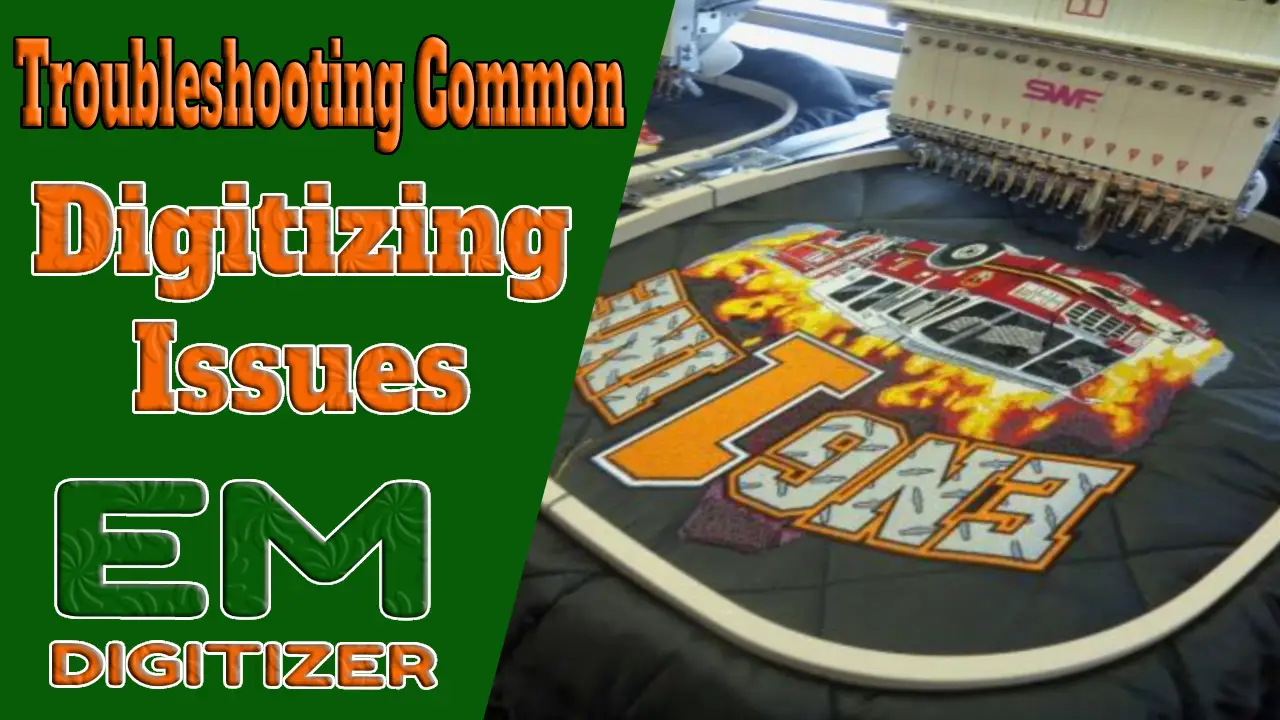

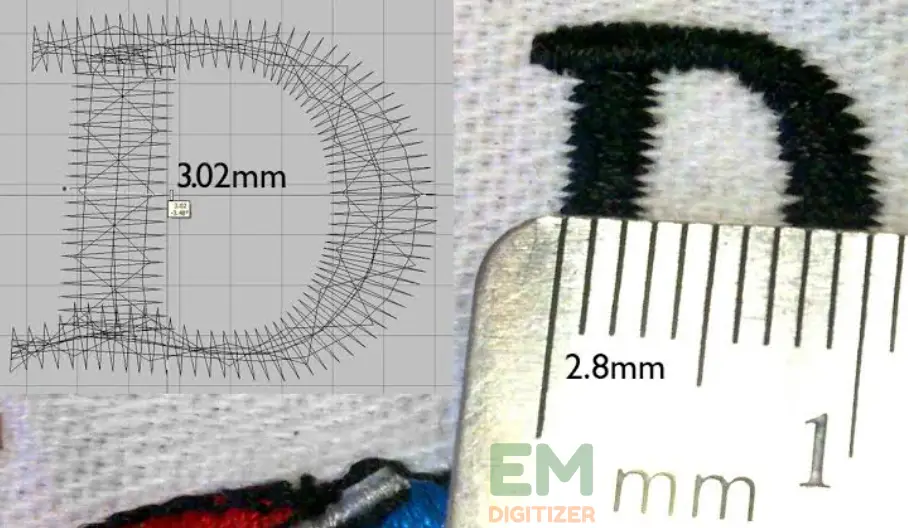
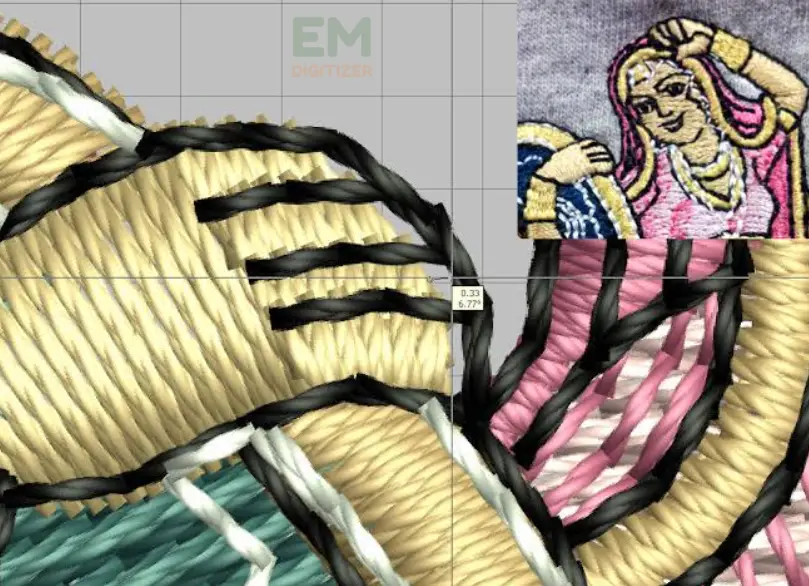

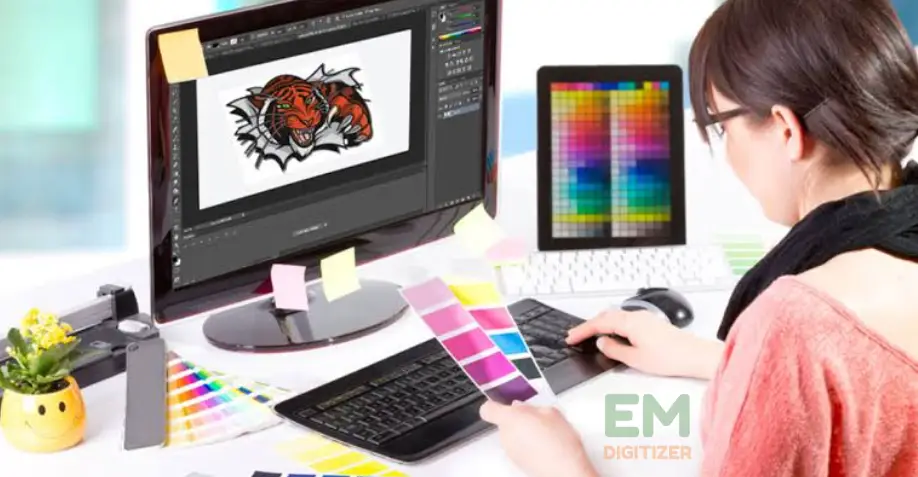
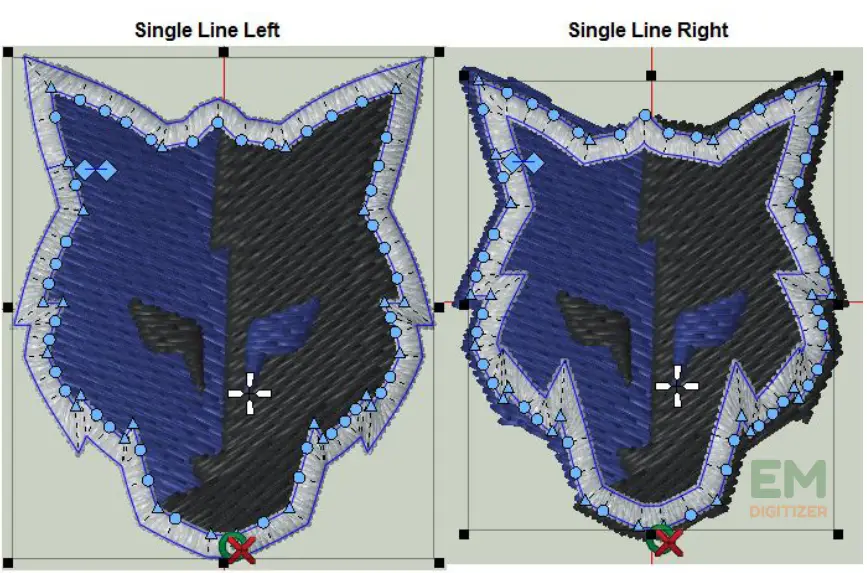

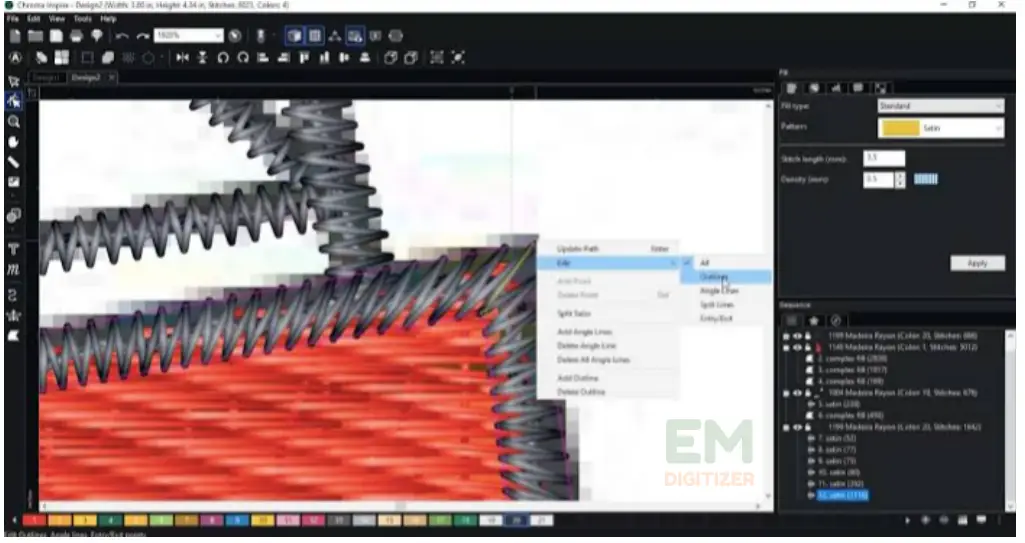


Digitizing dilemmas? Not anymore! Your troubleshooting guide is a lifesaver for tackling those pesky digitizing hiccups. From stitch density to pull compensation, you’ve got it covered. Thanks for the expert insights – now we’re ready to conquer any design challenge!
Stitching problem-solving guide! This post covers troubleshooting common digitizing issues, ensuring smooth and flawless embroidery designs. Master the art of problem-solving in stitching!